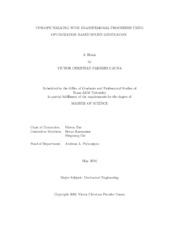| dc.description.abstract | Powered prosthetic devices are robotic systems that are aimed to restore the mobility of subjects with amputations above the knee by imitating the behavior of a normal human leg. Powered prostheses have diverse advantages compared to passive devices, including the possibility of reducing the metabolic cost of the user, providing net power into the walking gait and walking on diverse terrain. In particular, this thesis is focused on the capacity of powered transfemoral prostheses to adapt to diverse terrains. Since most terrains consist of flat and inclined surfaces, it is important that a transfemoral prosthesis can walk on these surfaces and have the capacity to seamlessly transition from one surface to another. However, currently available controllers require either intention recognition procedures that delay the terrain transition or a collection of parameters that require a large tuning process for each possible surface profile. In this thesis, we propose a framework that can generate automatically stable and human-like gaits for both surfaces with immediate transition between them. The new framework is based on human-inspired control and a spline-based trajectory generation. Specifically, the proposed method i) inserts a set of cubic splines that smoothly blend the flat ground joint trajectories into arbitrary upslope surface joint trajectories for the ankle and knee joints and ii) employs a low gain PD control for terrain adaptation for various unknown surfaces. This framework is implemented on the powered transfemoral prosthetic device, AMPRO II, for both flat ground and upslope walking to test its use as a nominal controller. The experimental results confirm that the proposed framework provides walking gaits for flat ground and upslope with seamlessly smooth transitioning gaits between them. | en |


